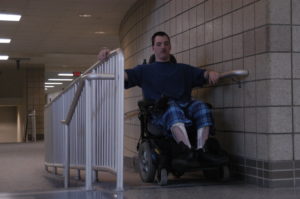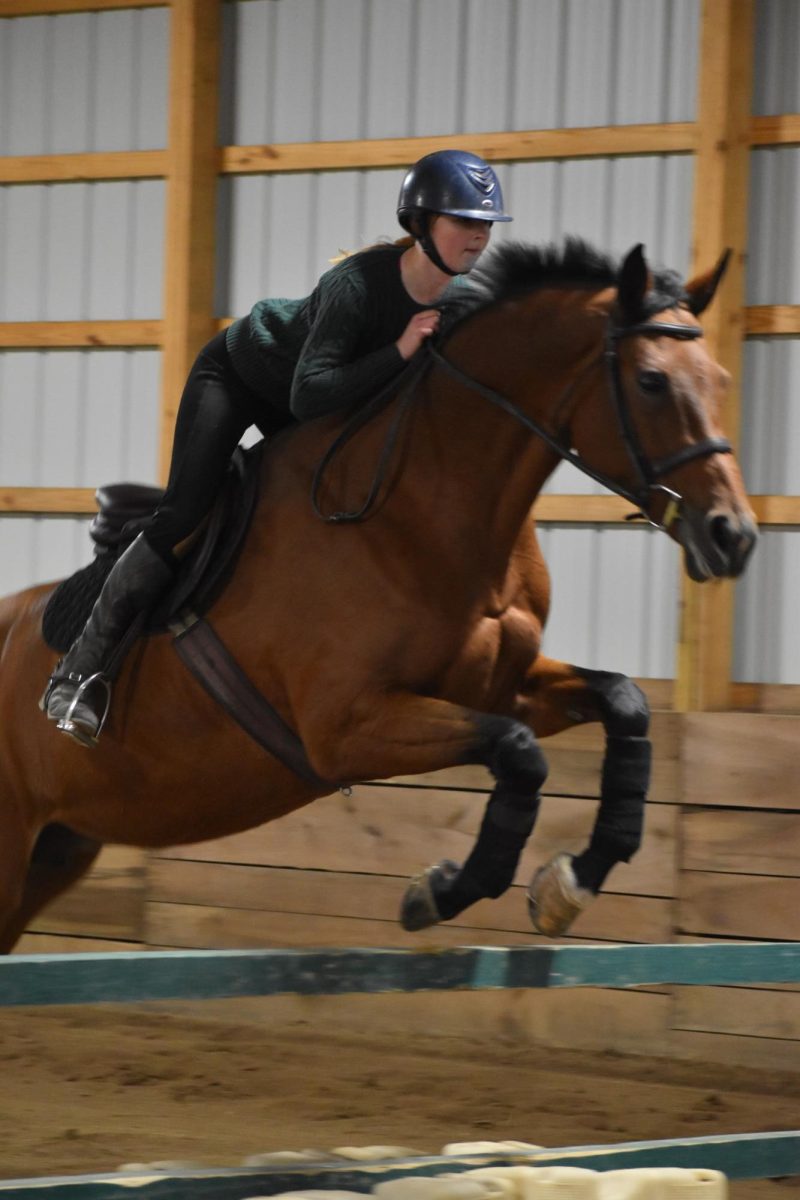 Student with physical disability takes action by placing “No Walking” signs on handicap-accessible ramp to help those who are in need
Student with physical disability takes action by placing “No Walking” signs on handicap-accessible ramp to help those who are in need
By Michelle Yun
<[email protected]>
Standing by the ramp with his cane up, sophomore Jordan Reel tried to reserve this ramp for only those who needed to use it. Since early December, he said he put up “No Walking” signs and asked Principal John Williams to make an announcement about the ramp. After seeing his friends having difficulties getting on the ramp by the planetarium, he decided to take action about the crowded ramps.
“My friends had trouble getting up the ramp in their wheelchairs. It was difficult for them to make it to class on time and it was dangerous,” Reel said. “I walk with a cane and was afraid someone would knock me down and I would break a bone going up the ramp. It was also dangerous for the people that would walk into the wheelchairs.”
According to statistics by the Research and Training Center on Disability in Rural Communities, 19,330 people in Hamilton County have a type of disability. At this school, there are students who have physical disabilities, some which require using the ramp.
Susan Kruse works with Reel and is the teacher and consultant of the orthopedically impaired students not only for CHS but also for the city of Carmel. Kruse described the problem. “The problem with the ramp is it’s very narrow and when the kids that are in wheelchairs or walkers tried to access it, many times, before [Reel] started his little campaign, you could not even get through the ramp,” Kruse said. “People and students were coming down three, two students wide and then the kids in the wheelchairs would just have to wait and they could not get up the ramp at all.”
Williams said the school might make the ramp near the auditorium wider or make the entire area a ramp. But this construction would not happen until the summer or next school year.
“We are going to look at ways to make that more user-friendly for all our students,” Williams said. Kruse said the problem with the ramp has always been present, but for whatever reason, Reel decided to work on making a change.
“He was constantly printing off signs and taping them up. Then custodians would take them down and he would put them back up,” Kruse said. “He was very involved in that.”
Senior Mike Davis, who uses a wheelchair, said the crowded ramp would irritate him and was glad that Reel took action.
“[The crowded ramp] was just aggravating,” Davis said. “I just wanted to yell at people. The main problem was, during dismissal, it was really busy and we had a lot of trouble getting through because the people were rushing down the ramp. It was really irritating because we had to just sit there for like five minutes because no one would move out of the way and the buses leave. They don’t wait because they leave early anyway. So, they leave at 3:15 if we’re not out there.”
Reel also said he was angry with crowded ramps and would continue with this “campaign” until permanent signs are put up.
“I feared I would get injured and I was upset at the school,” Reel said. “Most students will spend 12 years at public schools and the schools cannot take half an hour to educate people to stay out of the way of ramps so those who need them can use them.”
According to Kruse, ramps, automatic doors and other devices were initially for individuals who were disabled. However, they have now become what is known as universal design because everybody uses the automatic systems.
“When your arms are full, you hit the automatic door button. You know if you have something to carry, you go down the ramp.” Kruse said. “But the way this ramp is and a couple of the others, they are so narrow that the kids who actually need them can’t go up them because everyone else is using them. If the stairs were taken out and that whole area was ramp, then it wouldn’t be such a concern.”
According to Kruse, the newer sections of CHS were renovated conforming to the American Disabilities Act standards, while the older parts of the building did not.
“There is a ramp in the freshman center going to the cafeteria and one near Greyhound Station. These ramps meet code which states width and also what the incline needs to be ( measured in inches per feet),” Kruse said. “There are two ramps in the E building that do not meet code in terms of steepness. Those did not need to be revised as they were not part of new construction.”
Reel said most students and teachers were supportive of what he does. Junior Aysenaz Esen, however, said people should be allowed to use the ramps. She said she tried to get on the ramp only to be stopped by Reel who said she couldn’t pass and blocked the way. Esen said she felt this was a great inconvenience especially when people are rushing to class and it is hard to get by.
“I think that if there are disabled people then people who are not handicapped should allow them to use the ramp,” Esen said. “But, I think (blocking the ramp) is discrimination against people who have nothing wrong with them.”
Kruse said students do not intentionally block the ramp, but as they are going back and forth and chatting with their friends, they are just oblivious.
“The other day I was around, there was no one on the ramp and it was passing period so [Reel] did make a difference,” Kruse said. “So I think that it’s not necessarily needed as intense as he was. But he thinks that if he doesn’t keep doing it, people will go back to (walking on the ramp).
TERMINOLOGY
Impairment:
Anatomic or functional abnormality or loss which may or may not result in a disability. This is understood as the medical condition.
Disability:
The loss or reduction of functional ability which results from an impairment. This is understood as the functional consequence of a medical condition.
Handicap:
The disadvantage caused by the disability. This is understood as the social consequence. The handicap is therefore an artificial barrier which can usually be avoided with insight and proper planning for both the physical environment and the provision of services. People are only handicapped when the community and its representatives fail to consider the needs of people with disabilities – it has nothing to do with the disability itself.
PDCNSW.ORG / SOURCE


































![British royalty are American celebrities [opinion]](https://hilite.org/wp-content/uploads/2024/03/Screenshot-2024-03-24-1.44.57-PM.png)



















![Chelsea Meng on her instagram-run bracelet shop [Biz Buzz]](https://hilite.org/wp-content/uploads/2024/04/IMG_2446-1200x838.jpg)
![Review: Quiet on Set: The Dark Side of Kids TV is the long awaited exposé of pedophilia within the children’s entertainment industry [MUSE]](https://hilite.org/wp-content/uploads/2024/04/unnamed.jpg)
![Review: “The Iron Claw” cannot get enough praise [MUSE]](https://hilite.org/wp-content/uploads/2024/04/unnamed.png)
![Review: “The Bear” sets an unbelievably high bar for future comedy shows [MUSE]](https://hilite.org/wp-content/uploads/2024/03/unnamed.png)
![Review: “Mysterious Lotus Casebook” is an amazing historical Chinese drama [MUSE]](https://hilite.org/wp-content/uploads/2024/03/0.webp)
![Review in Print: Maripaz Villar brings a delightfully unique style to the world of WEBTOON [MUSE]](https://hilite.org/wp-content/uploads/2023/12/maripazcover-1200x960.jpg)
![Review: “The Sword of Kaigen” is a masterpiece [MUSE]](https://hilite.org/wp-content/uploads/2023/11/Screenshot-2023-11-26-201051.png)
![Review: Gateron Oil Kings, great linear switches, okay price [MUSE]](https://hilite.org/wp-content/uploads/2023/11/Screenshot-2023-11-26-200553.png)
![Review: “A Haunting in Venice” is a significant improvement from other Agatha Christie adaptations [MUSE]](https://hilite.org/wp-content/uploads/2023/11/e7ee2938a6d422669771bce6d8088521.jpg)
![Review: A Thanksgiving story from elementary school, still just as interesting [MUSE]](https://hilite.org/wp-content/uploads/2023/11/Screenshot-2023-11-26-195514-987x1200.png)
![Review: When I Fly Towards You, cute, uplifting youth drama [MUSE]](https://hilite.org/wp-content/uploads/2023/09/When-I-Fly-Towards-You-Chinese-drama.png)
![Postcards from Muse: Hawaii Travel Diary [MUSE]](https://hilite.org/wp-content/uploads/2023/09/My-project-1-1200x1200.jpg)
![Review: Ladybug & Cat Noir: The Movie, departure from original show [MUSE]](https://hilite.org/wp-content/uploads/2023/09/Ladybug__Cat_Noir_-_The_Movie_poster.jpg)
![Review in Print: Hidden Love is the cute, uplifting drama everyone needs [MUSE]](https://hilite.org/wp-content/uploads/2023/09/hiddenlovecover-e1693597208225-1030x1200.png)
![Review in Print: Heartstopper is the heartwarming queer romance we all need [MUSE]](https://hilite.org/wp-content/uploads/2023/08/museheartstoppercover-1200x654.png)






















![Review: Ladybug & Cat Noir: The Movie, departure from original show [MUSE]](https://hilite.org/wp-content/uploads/2023/09/Ladybug__Cat_Noir_-_The_Movie_poster-221x300.jpg)

![Review: Next in Fashion season two survives changes, becomes a valuable pop culture artifact [MUSE]](https://hilite.org/wp-content/uploads/2023/03/Screen-Shot-2023-03-09-at-11.05.05-AM-300x214.png)
![Review: Is The Stormlight Archive worth it? [MUSE]](https://hilite.org/wp-content/uploads/2023/10/unnamed-1-184x300.png)

